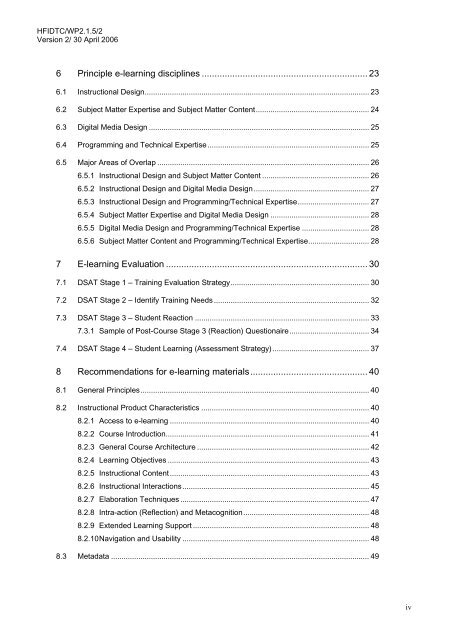E-learning Instructional Design Guidelines - Human Factors ...
E-learning Instructional Design Guidelines - Human Factors ...
E-learning Instructional Design Guidelines - Human Factors ...
You also want an ePaper? Increase the reach of your titles
YUMPU automatically turns print PDFs into web optimized ePapers that Google loves.
HFIDTC/WP2.1.5/2<br />
Version 2/ 30 April 2006<br />
6 Principle e-<strong>learning</strong> disciplines ................................................................. 23<br />
6.1 <strong>Instructional</strong> <strong>Design</strong>........................................................................................................... 23<br />
6.2 Subject Matter Expertise and Subject Matter Content...................................................... 24<br />
6.3 Digital Media <strong>Design</strong> ......................................................................................................... 25<br />
6.4 Programming and Technical Expertise ............................................................................. 25<br />
6.5 Major Areas of Overlap ..................................................................................................... 26<br />
6.5.1 <strong>Instructional</strong> <strong>Design</strong> and Subject Matter Content ................................................... 26<br />
6.5.2 <strong>Instructional</strong> <strong>Design</strong> and Digital Media <strong>Design</strong> ....................................................... 27<br />
6.5.3 <strong>Instructional</strong> <strong>Design</strong> and Programming/Technical Expertise.................................. 27<br />
6.5.4 Subject Matter Expertise and Digital Media <strong>Design</strong> ............................................... 28<br />
6.5.5 Digital Media <strong>Design</strong> and Programming/Technical Expertise ................................ 28<br />
6.5.6 Subject Matter Content and Programming/Technical Expertise............................. 28<br />
7 E-<strong>learning</strong> Evaluation ............................................................................... 30<br />
7.1 DSAT Stage 1 – Training Evaluation Strategy.................................................................. 30<br />
7.2 DSAT Stage 2 – Identify Training Needs .......................................................................... 32<br />
7.3 DSAT Stage 3 – Student Reaction ................................................................................... 33<br />
7.3.1 Sample of Post-Course Stage 3 (Reaction) Questionaire...................................... 34<br />
7.4 DSAT Stage 4 – Student Learning (Assessment Strategy).............................................. 37<br />
8 Recommendations for e-<strong>learning</strong> materials.............................................. 40<br />
8.1 General Principles............................................................................................................. 40<br />
8.2 <strong>Instructional</strong> Product Characteristics ................................................................................ 40<br />
8.2.1 Access to e-<strong>learning</strong> ............................................................................................... 40<br />
8.2.2 Course Introduction................................................................................................. 41<br />
8.2.3 General Course Architecture .................................................................................. 42<br />
8.2.4 Learning Objectives ................................................................................................ 43<br />
8.2.5 <strong>Instructional</strong> Content............................................................................................... 43<br />
8.2.6 <strong>Instructional</strong> Interactions......................................................................................... 45<br />
8.2.7 Elaboration Techniques .......................................................................................... 47<br />
8.2.8 Intra-action (Reflection) and Metacognition............................................................ 48<br />
8.2.9 Extended Learning Support .................................................................................... 48<br />
8.2.10 Navigation and Usability ......................................................................................... 48<br />
8.3 Metadata ........................................................................................................................... 49<br />
iv
















